
The U.S. Department of Navy has been mandated to derive at least 50 percent of its energy consumption from alternative sources by 2020. Peanuts have made the cut for potential sources, but can this new fuel-based market for peanuts be fostered?
Peanut oil is an excellent feedstock for transportation fuels, particularly for the high-powered specific fuel the Navy needs to fill its mandate. Peanut oil is also a good source for what is called ‘drop-in’ jet and diesel alternative fuels, which can be used with little or no alterations to an engine’s system, which is the way the Navy wants it. All of this was confirmed by Applied Research Associates, a respected lab in Panama City, Fla., which conducted tests this year on peanut oil to see if it could work for the Navy.
Peanuts were not at first on the Navy’s sonar, which was tuned to things such as soybeans and canola as alternative feedstock. How did peanuts get in the Navy’s sights? And who sent the peanut oil samples to the Panama City lab in the first place to get tested?
The story was told during the Southern Peanut Growers Conference in Sandestin, Fla., July 22. Less than 18 months prior, Ronnie Davis, the head of USDA Rural Development in Alabama, caught wind from his higher-ups that the Navy was looking for renewable energy feedstock. He sat in on a few meetings, a few meetings included Navy officials, and from those meetings peanuts got put on the Navy’s list for possible fuel sources.
The Navy is on its way to meeting its mandate. As the peanut conference was taking place in Florida, the US Navy was showcasing what it calls its Great Green Fleet capabilities at RIMPAC 2016, where American ships fueled ships from eight other nations with drop-in alternative-fuel. (RIMPAC is the Rim of the Pacific Exercise, and it takes place during the summer of even number years and is considered world's largest international maritime warfare exercise.)
Having gained the Navy’s interest in peanut-based fuel, Davis contacted Marshall Lamb at the USDA National Peanut Lab in Dawson, Ga., to help prove peanuts can cut the mustard for the Navy. The two joined forces and along with Caleb Bristow with the Alabama Peanut Producers Association located the Panama City lab and delivered the peanut oil samples used to declare its findings.
Opportunity for peanut farmers?
And that is where everything sits now: The Navy is interested in peanuts because the legume has been proven to be a good alternative fuel feedstock; the Panama City lab actually says it’s a darn-good source. The cart is made so to speak; the peanut industry now needs to find enough material to fill the cart and charge the right horse to drive it to market. And Lamb says this is an opportunity for peanut farmers to take the reins.
The peanut has the potential to produce 100-plus gallons of oil per acre, which is more than canola or soybeans, which can produce 75 gallons per acre and 65 gallons per acre respectively. The challenge for peanuts is the cost.
According to Lamb, the cost to convert peanut to fuel is about $1 per gallon. With that in mind, to make a gallon of fuel buying oil stock from shellers would cost about $4.50. Fuel from farmer stock peanuts would cost about $7 per gallon, which includes the shelling and conversion costs. These prices are much higher than petroleum fuel right now, which is around $2 a gallon to buy today. The Navy’s mandate says the prices it pays for alternative sources must come close to petroleum prices; a tall order but that’s what it says.
So, what can be done about the cost of peanut oil, or make it more competitively appealing to the Navy? Lamb says peanut oil prices can be controlled by the way farmers produce them and keeping the value of the peanuts closer to the farm. What if a grower could produce a ton of peanuts for $175.
New way of thinking peanut production
The dominate runner-type peanut produced today is the Georgia-06G because of its good disease, high-yield and quality package. But there are many cultivars of peanuts that have great disease-resistance capabilities that are not at this time desired for food use. Using these varieties along with conservation tillage and the minimum use of fungicide and herbicide inputs can go far to help a farmer produce an acre of peanuts for fuel but do it cheaper than what is required to produce an acre of high-quality peanuts for food use.
The cost of peanut production can also be reduced, Lamb said, by drying peanuts in windrows and shelling them while harvesting. A combine can be modified to shell peanuts during harvest and do a good job at the shelling. It’s been done and can be done.
The big unknown and the thing most out of a farmer’s control is the price of petroleum and competing feedstock sources. Right now, Lamb and Davis are seeking funding to do a feasibility study on an oil crushing facility to target fuel production using peanuts, carinata (a type of mustard) and other feedstock sources grown in the South.
Those championing peanuts as a fuel source for the Navy, or for commercial planes for that matter, are serious. But to trigger this fuel market will take organization and cooperation. The timing might be right. The U.S. peanut is a thriving and valuable industry and food source, a staple. But the legume can offer much more from its pod. A military mandate might just be the spark to extract that potential now.
About the Author(s)
You May Also Like






